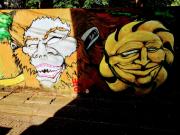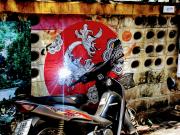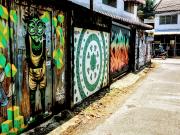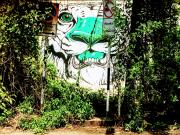In Chiang Mai, the walls really do speak
By JJ Rose
CHIANG MAI, an hour’s flight north of the Thai capital Bangkok, has long been a favourite among backpackers and for those seeking access to the wilds of northern Thailand.
Laid out flat, in the belly of a valley surrounded by steep, rolling hills of jungle, the city of some 170,000 sprawls outwards from the Old City, which is ringed by a centuries-old moat, lined with crumbling fortress ruins.
Once the capital of the Lan Na kingdom, between the 13th and 18th centuries, Chiang Mai has preserved a sense of distinction from the commercial south, centred on the massive metropolis of Bangkok.
It is heavily influenced by Burmese culture – the Burmese capital Yangon is the same flight time as Bangkok – and many Chiang Mai’ers have some kind of Burmese connection.
This separation is enhanced by the fact that the city is a centre for the ‘Red Shirt’ faction in Thai politics, which grew out of the turbulent five-year Prime Ministership of Thaksin Shinawatra. In 2005-2006, Thailand was fractured by the clash between the Red Shirts and the Yellow Shirts and outbreaks of violence in Bangkok bordered on civil war.
The Yellows tend to be more establishment oriented and broadly ‘right wing.’ The Reds are more liberal, anti-elitist and ‘leftist.’
‘Digital nomads’ and street artists
Recently, the city of Chiang Mai has become a hub for so-called ‘digital nomads’, the name given to those lucky souls who have managed to find a way to work digitally and remotely from the sources of their income.
A laid-back lifestyle, and generally excellent wi-fi connections across the city, give Chiang Mai’ers a sense of freedom from the world, whilst maintaining a connection to it. Expats, working laptops and phones in cafes and restaurants, are among Chiang Mai’s everyday scenes.
The city’s growing cosmopolitanism and confidence has inspired a generation of street artists. Drawn from the ranks of both ex-pats (ex-patriots) and locals, these creators make their art openly in public spaces, often encouraged to do so by the owners of the walls and buildings that become their canvasses.
Thais tend not to paint their home exteriors, so neighbourhoods can seem a little drab. The backstreets of Old City, for instance, are often dour and dingy, fascinating to wander, but somewhat devoid of colour.
They are lifted by the vibrant abstracts and Realist imagery of its street artists, spraying life onto outer walls of homes, hotels and offices.
One well-known street artist, Iago, a native of Barcelona and owner of the t-shirt store Iagazzo, told me that the legality of street art was a little blurred. Generally, he said, police will not bother anyone who has the permission of the property owner.
“And,” he added, “as long as you stay away from politics and religion.”
Political landscapes
Despite this, the political line seems moveable.
One Thai artist, known as San Chai, has become well-known for branding his work with the letters RIP CNX. The epithet is a comment on the struggle in Chiang Mai between development and civil space (CNX is the code for Chiang Mai’s international airport).
Politics also has a role to play in the ownerships of the ‘canvas’ for the artists. Once you have your art on a wall or surface, that space is yours, with others only allowed to operate there by invitation.
During the time I was there, one French artist was ruffling feathers in the local street art community by subverting this unwritten law and ‘hi-jacking’ space for his own art.
The style of Chiang Mai’s street art is hugely varied and artists tend to have a specific style or brand by which they are recognised.
Ignazio tends to go for patterns and abstracts, following a vision of harmony and balance that he wants to be interpreted as a global ideal.
Others, like San Chai, have developed a character brand – in his case The Green Man – which peers out from the concrete walls like a geeky, omniscient comedian. Another Thai artist generally does animals, especially elephants.
At its core, like many street art movements around the world, is a fundamental belief in civic potential and in street level politics, nominally removed from the hand of government and big business. This is people’s art and is meant to be seen as such, and accessible – conceptually as well as physically – to all.
Despite this, some companies have inveigled themselves into the movement.
A few walls are covered in the usual jumble of street art colour and life, but reveal, on closer viewing an embedded brand name or reference. Some street artists have been hired by restaurants and cafes to help them stand out via some vibrant art on their external walls.
Locals reclaiming Chiang Mai
While reclaiming Chiang Mai for Chiang Mai’ers is central to its street artists’ ideals, this should not be read as a being anti-foreigner or anti-tourist.
Iago, who is as noted, himself, an interloper, told me that local artists welcomed tourism as an economic driver and saw tourists as generally acceptable. Reaching an international audience with their street art in such a landscape was indeed a useful side-benefit of a city brimming with wide-eyed overseas visitors.
As the city grows, its street art is likely to expand too. The grey and brown wood functionality of the urban landscape will be coloured and brought to life by this talented core of artists and its overseas interlopers.
While Chiang Mai is not short of more conventional tourist attractions and atmosphere, for those wanting to catch a glimpse of the real Chiang Mai, the city’s walls have plenty to say.
#ends
- Hits: 1495











